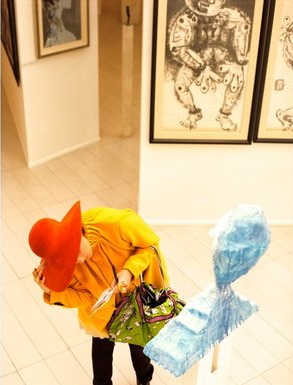One of the big advantages of being an art critic is that you never have to think about presents. I don’t mean we never give any — art critics may be savage, ruthless and cruel, but we’re not ogres! No. We give presents. But we don’t have to think about what to give because we always give the same thing. Art.
Wedding coming up? Give them art. Gran celebrating her 100th birthday? Give her art. Baby born? Give it art. Somebody leaving? Big hugs. Then art. Christmas? Art all round! This constantly giving art approach isn’t for everyone, of course. But one thing it does give you is tons of experience in acquisition. Experience that I pass on below with Waldemar Januszczak’s Five Golden Rules of Buying Art.
Decide immediately
This may not sound like good advice, but it is. Some people — especially dealers — will try to convince you that art needs to be thought about slowly so that its full effects and deeper mysteries can reveal themselves to you. This is BS. Art is a visual medium. That is how it needs to be judged. Years ago, in the days when Charles Saatchi was still speaking to me, he invited me to join him on one of the Saturday morning buying expeditions with which he was changing the face of art. In those days, everything Saatchi did turned to gold. No collector, ever, had transformed the art world as successfully as he was transforming it. What he did was hire a London taxi and settle himself in the back seat with a huge pile of gallery invitations shoved into a plastic bag. Rifling through the bag, he’d bark addresses of anything that took his fancy at the driver. As soon as we arrived at the gallery, he jumped out and went in. I followed and began reading the first caption. Before I had time to finish it, he was back in the taxi calling for me. One look and he knew.
Bid in auctions
Let me quickly add that by auctions I do not mean Sotheby’s, Christie’s, Bonhams etc. Those are hunting grounds for the rich, and no place for the fiscally concise present-giver. My auctions are tiny events in small auction houses that are repeated in Britain every day of every week. Small auctions are not the best places to buy contemporary art, but they are fabulous resources for jewellery, ceramics, vintage clothing, old photographs, Georgian candlesticks, film posters and so on. Why anyone would wish to buy a new silver picture frame from Liberty, when they can get a beautiful old one at auction for a tenth of the price, is beyond me. For an immediate sense of what you can get, I recommend a visit to my favourite auction website, the-saleroom.com, where every auction coming up in Britain is listed, with a catalogue of everything they have for sale. You can bid live on the internet. And they have a delivery service.
Avoid art fairs
This really shouldn’t need saying, but judging by the annual frenzy caused by that ghastly event the Frieze Art Fair, lots of people still seem to believe that they might find something worth buying there. You won’t. Art fairs are not for you and me. They may pretend to be, but it’s a lie. Art fairs are occasions for dealers to fleece you, and for rich collectors from Miami, Moscow and Kiev to be fleeced. My daughter went to Frieze this year. She’s a student. At the door, she was told she could not go in with her rucksack and she had to put it in the cloakroom. So she went to the cloakroom where they charged her £5 for leaving her bag! Art fairs behave this way because their sole function is to make money. The fair charges the dealer huge amounts for a stall. So the dealer charges you huge amounts for an artwork. Those are not conditions in which you will ever pick up a bargain.
Go to degree shows
At the end of every art-school year, every art school in the country has a degree show. And every degree show is an opportunity for graduating students to display their work and for you to buy it. Unlike art fairs, degree shows are driven by a genuine interest in art. And because the students are starting out, the prices are beginner’s prices. It’s a splendid opportunity to get things. And providing you follow Rule 1: only buy what you immediately like, it cannot disappoint. Occasionally, you may even strike it lucky and acquire something valuable.
Bust the bank if you have to
This is also controversial. You’ll think I am recommending financial suicide by encouraging you to spend beyond your means. I’m not. But I have noticed that the best things I have ever bought — so wonderful that I cannot actually give them away — have screamed “Buy me!” so loudly that I could not ignore them. Whatever it took, I had to buy.
The first one I remember was something I saw in Paula Rego’s first London exhibition. It was a picture of a woman with big scissors cutting the tail off a vomiting monkey! Blimey, I thought. That is some serious pictorial angst being expressed there. It was a couple of hundred quid. Way beyond what I could afford at the time. Ninety-nine times out of a hundred, I would have said no. This time, the picture wouldn’t let me. So I worked out a rough-and-ready hire-purchase agreement with the gallery, and it was mine.
When it gets like that, you have to bust the bank. The vomiting monkey must have been one of Rego’s favourites, too, because I keep having to lend it to retrospectives and the like. Useless Christmas present. Great buy.

